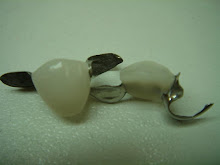All these photos need to do scaling and air polishing to remove all the stains and tartars.
 The cumulative effects of a number of different processes can affect the color of a person's teeth:
The cumulative effects of a number of different processes can affect the color of a person's teeth:1. Chromogenic foods - mostly refer to beverages that when consumed over time have the ability to produce a staining effect on teeth. Coffee, tea, cola, and red wine are all well-known chromogenic agents.
2. Tobacco products - The cumulative effect of the use of cigarettes, cigars, pipes, and even smokeless tobacco can cause tooth staining.
3. Medications - The use of some medicines can cause tooth discoloration.
4. Physiological processes - There can be a number of physiologic processes, both normal and pathological, that can have an affect on a tooth's color. Especially related to the fact that a person's tooth discoloration might be caused by tooth pathology, it is always best that all teeth whitening efforts should begin with an examination by a dentist.
5. Aging - It is a normal event that a person's teeth will darken with age.
6. Tooth decay - Locations where tooth decay exists are typically brown to black in color. The decay itself may be on an aspect of the tooth that is not directly visible but the staining it causes can be visible through portions of the tooth that seem intact. Of course teeth whitening products cannot resolve the problems caused by tooth decay. Obviously the needed solution in this type of situation is for the person's dentist to repair the damage caused by the decay way of placing dental restorations (fillings, crowns or veneers).
7. Tooth trauma - Teeth that have experienced trauma (like being hit in an accident) can discolor. In some cases this discoloration may be an indication that the nerve inside the tooth has died. While the use of a teeth whitening product may lighten the color of a necrotic tooth it will not resolve the underlying problem. In this type of situation not seeking an evaluation and subsequently receiving treatment from your dentist can lead to a serious tooth flare up.

 Tartar is the hardened product of longstanding plaque accumulating minerals from the saliva and foods.
Tartar is the hardened product of longstanding plaque accumulating minerals from the saliva and foods.





















No comments:
Post a Comment